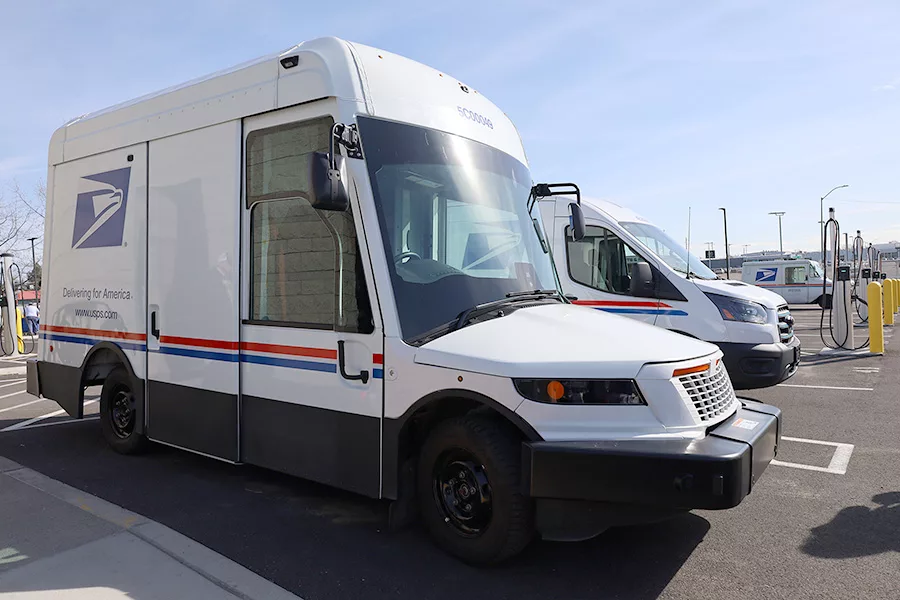
Home » Pasco postal fleet to add nearly 100 new EVs
Pasco postal fleet to add nearly 100 new EVs
U.S. Postal Service invests $135M in improvements WA

As part of a nationwide Delivering for America plan, the U.S. Postal Service is investing $40 billion in improvements to its postal network – including updating its outdated fleets. Pasco will start seeing new electric vehicles, including nearly 100 specially designed for postal deliveries.
Photo by Rachel VisickApril 14, 2025
As a part of a series of upgrades in the Tri-Cities and across the nation, a Pasco postal facility is growing a fleet of electric vehicles, including some uniquely designed for postal deliveries.
As part of the Delivering for America plan, the U.S. Postal Service is investing $40 billion in improvements to its postal network across the country, including $135 million in Washington state.
Officials showcased some of these improvements at a recent media tour of the Pasco facility. A number of electric vehicles have been integrated into the fleet, as well as new next generation delivery vehicles, or NGDVs, with a special design.
“Prior to the initiation of the Delivering for America plan, our facilities and vehicles were in a state of significant disrepair. … This not only hampered efficiency, but also took a toll on morale, underscoring the urgent need for our improvements,” said USPS District Manager Trent McNeal at the event.
Currently, USPS uses long life vehicles, or LLVs. These vehicles have been in service for 30 years, but are no longer effective, said Tracy Powers, executive manager for fleet operations for USPS.
In Washington state, $37 million has been dedicated to replacing the fleet with modernized vehicles, Powers said. Already, 1,000 vehicles have hit the streets.
The plan is to deploy a total of 106,000 vehicles across the U.S. in the next five years, including more than 50,000 NGDVs, he said.
“Our new vehicles will not just make the postal service more competitive, but they will represent our commitment to (being) environmentally sustainable and improving the experience of our employees,” McNeal said.
Unique design
The NGDVs’ unique design is specialized for postal delivery. Both gasoline-run and electric models have driver’s seats on the right-hand side for deliveries.
Some of the vehicle’s features include automatic emergency braking, blind spot warning, 360-degree cameras and air conditioning. There are also adjustable seatbelts, airbags and adjustable shelves.
The vehicles are instantly noticeable, with a low hood for more visibility and a tall cargo area, allowing carriers standing over 6 feet tall to access packages without stooping or bending over.
The cargo area also is double the typical size, eliminating the need for second trips when there are large loads, Powers said. Despite the larger vehicle size, they are more efficient and will have lower maintenance costs.
The NGDV displayed during the tour has been used in Pasco for the past two or three months and already has 4,000 miles on it. It’s called an ICE, or internal combustion engine, and can travel longer distances than the EVs.
In total, Pasco will be getting 96 EV NGDVs and 16 ICE NGDVs to complement around 50 EV vans in the fleet.
Other upgrades
Pasco’s sorting and delivery center, or S&DC, is itself one of the enhancements under the Delivering for America plan. The center was transformed into an SD&C last year, the first facility of its kind in the state.
With 95 S&DCs open and 400 more planned to open across the U.S., these centers help streamline processing and delivery operations, said Gregg Thurston, USPS S&DC implementation specialist.
“We’re seeing cost savings from transforming the facilities we already own to meet current and future operational needs,” he said. “We installed new, modern package sorting machines to process packages much faster and more ergonomically than before when we sorted them by hand.”
In Washington, $13 million has been spent buying 11 sorting machines, two of which are featured in the Pasco S&DC.
Through the Pasco center, 166 mail carriers deliver to 261,100 customers.
Local News Environment Transportation
KEYWORDS April 2025
Related Articles
Related Products





